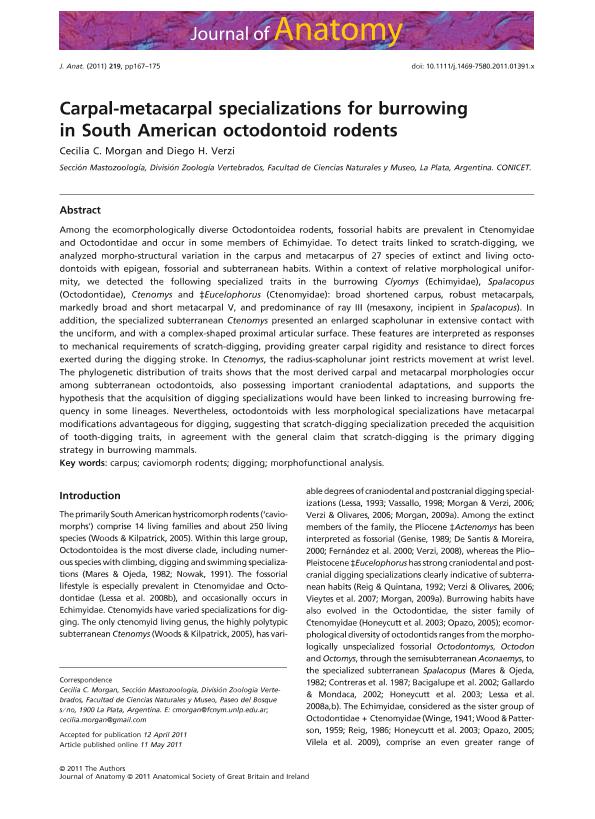Mostrar el registro sencillo del ítem
dc.contributor.author
Morgan, Cecilia Clara

dc.contributor.author
Verzi, Diego Hector

dc.date.available
2020-01-17T18:15:00Z
dc.date.issued
2011-08
dc.identifier.citation
Morgan, Cecilia Clara; Verzi, Diego Hector; Carpal‐metacarpal specializations for burrowing in South American octodontoid rodents; Wiley Blackwell Publishing, Inc; Journal of Anatomy; 219; 2; 8-2011; 167-175
dc.identifier.issn
0021-8782
dc.identifier.uri
http://hdl.handle.net/11336/95074
dc.description.abstract
Among the ecomorphologically diverse Octodontoidea rodents, fossorial habits are prevalent in Ctenomyidae and Octodontidae and occur in some members of Echimyidae. To detect traits linked to scratch‐digging, we analyzed morpho‐structural variation in the carpus and metacarpus of 27 species of extinct and living octodontoids with epigean, fossorial and subterranean habits. Within a context of relative morphological uniformity, we detected the following specialized traits in the burrowing Clyomys (Echimyidae), Spalacopus (Octodontidae), Ctenomys and †Eucelophorus (Ctenomyidae): broad shortened carpus, robust metacarpals, markedly broad and short metacarpal V, and predominance of ray III (mesaxony, incipient in Spalacopus). In addition, the specialized subterranean Ctenomys presented an enlarged scapholunar in extensive contact with the unciform, and with a complex‐shaped proximal articular surface. These features are interpreted as responses to mechanical requirements of scratch‐digging, providing greater carpal rigidity and resistance to direct forces exerted during the digging stroke. In Ctenomys, the radius‐scapholunar joint restricts movement at wrist level. The phylogenetic distribution of traits shows that the most derived carpal and metacarpal morphologies occur among subterranean octodontoids, also possessing important craniodental adaptations, and supports the hypothesis that the acquisition of digging specializations would have been linked to increasing burrowing frequency in some lineages. Nevertheless, octodontoids with less morphological specializations have metacarpal modifications advantageous for digging, suggesting that scratch‐digging specialization preceded the acquisition of tooth‐digging traits, in agreement with the general claim that scratch‐digging is the primary digging strategy in burrowing mammals.
dc.format
application/pdf
dc.language.iso
eng
dc.publisher
Wiley Blackwell Publishing, Inc

dc.rights
info:eu-repo/semantics/openAccess
dc.rights.uri
https://creativecommons.org/licenses/by-nc-sa/2.5/ar/
dc.subject
CARPUS
dc.subject
CAVIOMORPHS
dc.subject
DIGGING
dc.subject
MORPHOFUNCTIONAL ANALYSIS
dc.subject.classification
Biología

dc.subject.classification
Ciencias Biológicas

dc.subject.classification
CIENCIAS NATURALES Y EXACTAS

dc.title
Carpal‐metacarpal specializations for burrowing in South American octodontoid rodents
dc.type
info:eu-repo/semantics/article
dc.type
info:ar-repo/semantics/artículo
dc.type
info:eu-repo/semantics/publishedVersion
dc.date.updated
2020-01-15T20:03:17Z
dc.journal.volume
219
dc.journal.number
2
dc.journal.pagination
167-175
dc.journal.pais
Reino Unido

dc.journal.ciudad
Londres
dc.description.fil
Fil: Morgan, Cecilia Clara. Universidad Nacional de La Plata. Facultad de Ciencias Naturales y Museo. División Zoología de Vertebrados. Sección de Mastozoología; Argentina. Consejo Nacional de Investigaciones Científicas y Técnicas; Argentina
dc.description.fil
Fil: Verzi, Diego Hector. Universidad Nacional de La Plata. Facultad de Ciencias Naturales y Museo. División Zoología de Vertebrados. Sección de Mastozoología; Argentina. Consejo Nacional de Investigaciones Científicas y Técnicas; Argentina
dc.journal.title
Journal of Anatomy

dc.relation.alternativeid
info:eu-repo/semantics/altIdentifier/url/http://onlinelibrary.wiley.com/doi/10.1111/j.1469-7580.2011.01391.x/abstract
dc.relation.alternativeid
info:eu-repo/semantics/altIdentifier/doi/http://dx.doi.org/10.1111/j.1469-7580.2011.01391.x/abstract
Archivos asociados
